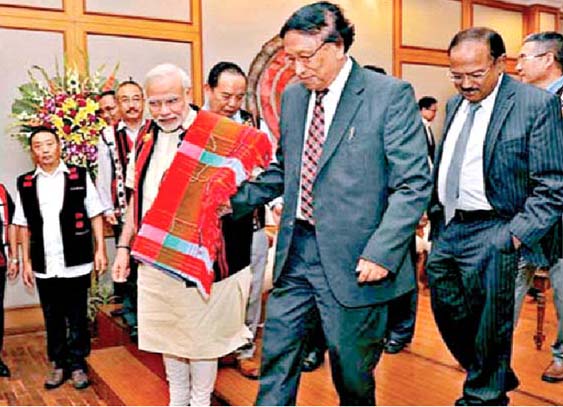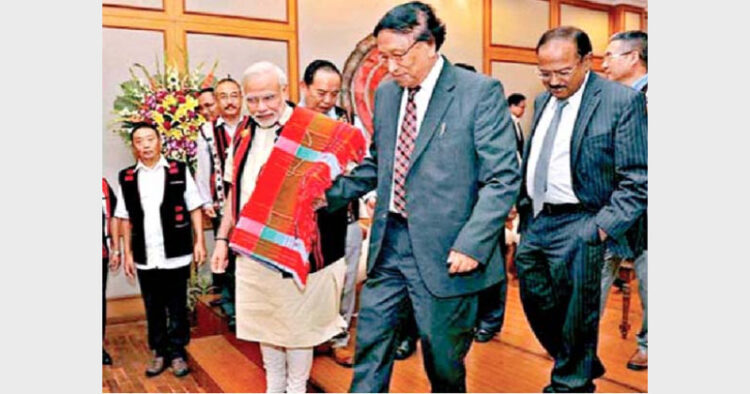
The younger generation the conflict to end at the earliest, so as, Nagaland can also enjoy the fruits in the form of Growth and inclusive progress
Although many noted Ethnographers, Anthropologist, travellers and explorers have introduced the mystical Nagas to the world in multiple tones; yet, my personal favourite is the one presented by R RShimray in his book “Origin and Culture of Nagas”. Shimray, who is a Naga himself, choose the following words to describe the Nagas, “Indeed, they are fierce-looking and hostile to those with bad intentions, but certainly not all the attributes are right. They are, on the contrary, very good to those who are good to them and friendly to those who are friendly and exceptionally hospitable to those who come with good intentions.”
The very evolution of the word Naga is interesting and has complex yet exciting contradictions. LipoklembaYaden or LL Yaden (Retd. IAS), who had served in various capacities and had also authored the book “Nagaland 1970” traced the etymological origin of the word Naga to the Assamese word N`O-GA`. Here N`O meant New and GA` denoted Body, thus meaning new body or new people. Therefore it is safe to decipher that the Naga people started inhabiting the present areas of Naga Hills post-migration and in all likelihood would have displaced its earlier inhabitants, probably the Deori’s, Chutiya’s, Kachari’s or the Moran tribes. However, the exact timeline of these migrations are unknown and as outlined by E.A Gait in his book “A History of Assam”, the Nagas were already inhabiting the nearby hills when the Ahoms arrived in the Brahmaputra Valley around the 13th Century. According to the Tirap district gazetteer, Ahom Buranjis ( Buranjis are Ahom Historical records) referred to the Nagas by the generic Assamese name Naga and also by their separate Assamese names like Khamjangias, Tablungias, Namsangias, Bordurias, Panidurias, Jaipurias and so on.
BB Kumar in “Landmarks in Indian Anthropology” revealed the methodical approach of Britishers to de-culturalise the Naga’s and wrote, “the British tried to make the Nagas Insular and the process was completed by the introduction of Inner Line Regulations In 1873 which prevented the entry of people from the plains to the Naga Hills while making exceptions to European speculators and foreign missionaries”. The British were very artful when it came at constructing binaries; they used Gun, the rule of Law and incentives in proportionate measure to isolate the Nagas from the Indian freedom struggle, cultivate Sub-Nationalism and create suspicion in the minds of unsuspecting Nagas against the Plainsmen. The colonisers were, to a large extent, successful in devising a separate political course for the Nagas to pursue and the crown colony policy is a testimony to it. It was these schemes of colonisers that severed the century-old socio-political, economic and marital ties between the hill tribes and the plainsmen that were extensively mentioned in the Ahom Burangies. They first formulated isolation that resulted in separation and then finally cultivated a separatist form of ethnonationalism that eventually caused one of the most prolonged conflicts in India post-Independence, the Naga conflict.
Rev. Michael Scott, a British missionary who had carried out extensive evangelist enterprises in the region also held Britain’s imperial policy responsible for keeping Nagaland isolated from the rest of India and placed the onus on Britain for the tragedies of the Naga conflict.
Both communist China and the Islamic Republic of Pakistan exploited the Naga conflict and covertly took part in it, and Naga insurgents too enjoyed the benefits of it. The ex-chief of the Naga army, PhuntingShimrang also accepted the role of China in the Naga Conflict in an interview to ‘THE WEEK’ in April 2017 and revealed that they had reached out to China in the initial years of the conflict. Another report published by the Institute of Conflict management published on its South Asia Terrorism Portal (SATP) alleged that ThuingalengMuivah had physically visited Karachi in January 2000 and Thailand authorities arrested him in Bangkok upon his return from Karachi for travelling on a fake South-Korean passport. NSCN (IM) had also maintained full-fledged liaison offices for liaisoning with China over the entire timeline of the Naga conflict.
While considering the timeline of the Naga conflict, it is conveniently deceiving for unsuspecting readers to develop a sense that it always was a consolidated effort of the Naga community. Whereas, on the contrary, it is full of episodes about betrayal and engineered inter-tribal feuds to fulfil personal ambitions. The inception of NSCN (IM) starts on a similar note, where it systematically sidelined the original stakeholders of the Naga community. The Naga National Council, the Naga Peoples convention, comprised of Village heads, tribal leaders and intellectuals of Nagaland, who were the actual stakeholders were brushed aside and coerced into silence. Th. Muivah, a native of the Tagkhul tribe, set the Semas against the Angamis and recruited large number Tangkhul youths loyal to him while using his influence as a General Secretary of NNC. He assassinated Phizo loyalists in an attempt to take control of the NNC and even called his godfather, Phizo a traitor. When other Tribal leaders refused to accept the overlordship of Tangkhuls, Th. Muivah split the NNC and formed NSCN, which later splintered again to NSCN (IM) and NSCN (K). NSCN (IM) willingly delayed the entire peace process to fulfil their ambitions and pushed the whole region into a bloodied conflict when a framework for a peaceful resolution was already chalked out between NNC and GOI.
Can’t agree on separate flag, constitution, says Ravi- The Centre’s interlocutor to Naga peace talks, Shri R N Ravi, has admitted that “differing positions” on the demand for separate Naga flag and constitution has delayed signing of the final peace agreement. According to Shri Ravi, the Centre was ready to consider Naga flag for pan-Naga cultural body and to term the final agreement as Naga “Yehzabo”. He, however, added that the Naga negotiators were not agreeable to it. Shri Ravi said that the Naga political issue is a very old and complex one. “In the last four years the negotiating parties have made significant continuous progress by resolving several facets of it. Like political parameters of settlement and the specifics of various competencies to be shared between the Naga people and the government of India. All issues have been mutually understood and agreed. However, few issues mainly a flag and a constitution are sticky. On these issues, the two sides have differing positions. We will sign the agreement as soon as these are resolved,” he added. The interlocutor said the Centre respects the unique history, rights and identity of the Naga people. “Final agreement must unambiguously convey the unity of Nagas with the Indian Union.” He said the ‘thriving political economy of insurgency in Nagaland run by a network of undergrounds and over-ground collaborators’. The government’s effort is to end this vicious cycle. However, he said: “Naga peace talks are at the concluding stage. Political principles of settlement, substantive issue of competencies and structural issues of governance have all been mutually agreed. The peace process has become truly inclusive with the seven Naga groups coming onboard. We have mutual understanding with NSCN (IM) that they would not oppose the NNPGs constructive cooperation in the peace process and their participation in the final agreement. The peace process can conclude any day.” On NSCN (IM) general secretary Th. Muivah’s allegation that Centre was using NNPGs as a ‘parallel force’, Shri Ravi said: “Mr. Muivah is a very senior leader for whom I have very high regards. He is aware of the background, circumstances and reality of the inclusion of NNPGs in the peace process. He knows that exclusion of other groups will be a recipe for violence after the final settlement. I am sure he does not meant what he said.” — Organiser Bureau
HotoviSema, an independent researcher from Dimapur, wrote the following about these inter-tribal feuds and events of brutal domination by the Th. Muivah’s NSCN (IM) in an Op-ed titled the “The rise and fall of Muivah in Nagaland” the Sentinel as, “There was simmering anger against whole of the Tangkhul community for Muivah’s selective killings of non-Tangkhul leaders. Angamis were killed in Kohima, Aos were killed in Mokokchung, Semas were killed in Zunheboto, Konyaks were killed in Mon, and Sangtam/Chang/Phom/Yimchunger were killed in Tuensang and Chakhesangs were killed in Phek – their home districts. By whom? Tangkhuls – the outsider community from Manipur causing havoc in Nagaland.”
The treatment meted out by Muivah’s insurgent group on the non-Tagkhuls reached a tipping point in 2000, when the Nagas of Nagaland served Tangkhuls in Nagaland a quit notice. Although things have changed from then, yet the UPA regime displayed a parochial understanding of the issue and engaged primarily with NSCN (IM) while ignoring other Tribes, their unique and distinct hopes and aspirations. However, RN Ravi, the chief interlocutor in the Naga peace process is well aware of these complexities and as per sources have the need route of engaging with all stakeholders to arrive at an amicable solution. This engagement with all stakeholders and breaking apart of the established monopoly of NSCN (IM) has also caused some anxiety in Camp Hebron, and a spirit haste seems to prevail in concluding the Naga Peace Accord.
The sense of hastiness shown by the NSCN (IM) also has another side to the story. In the last five to six years, the region has seen unprecedented development, likes of which was not witnessed earlier. Previously, the arms of governance were either hijacked with Guns or were embezzled, but now the present government schemes have genuinely reached out to the underprivileged. Concomitantly, the younger generation, which eventually will take up the reigns are far better informed than their predecessors and wants this conflict to end at the earliest, so as, Nagaland can also enjoy the fruits in the form of Growth and inclusive progress.














Comments